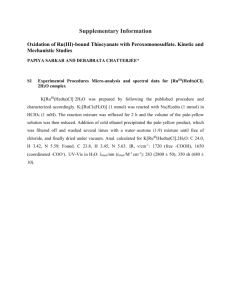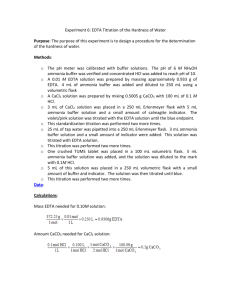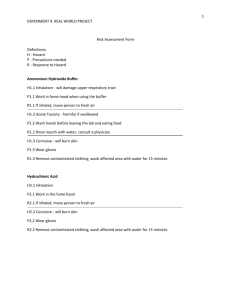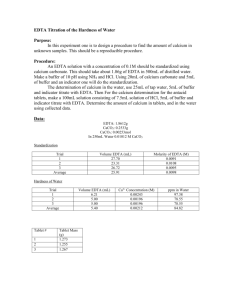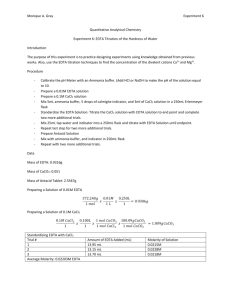lab six
advertisement
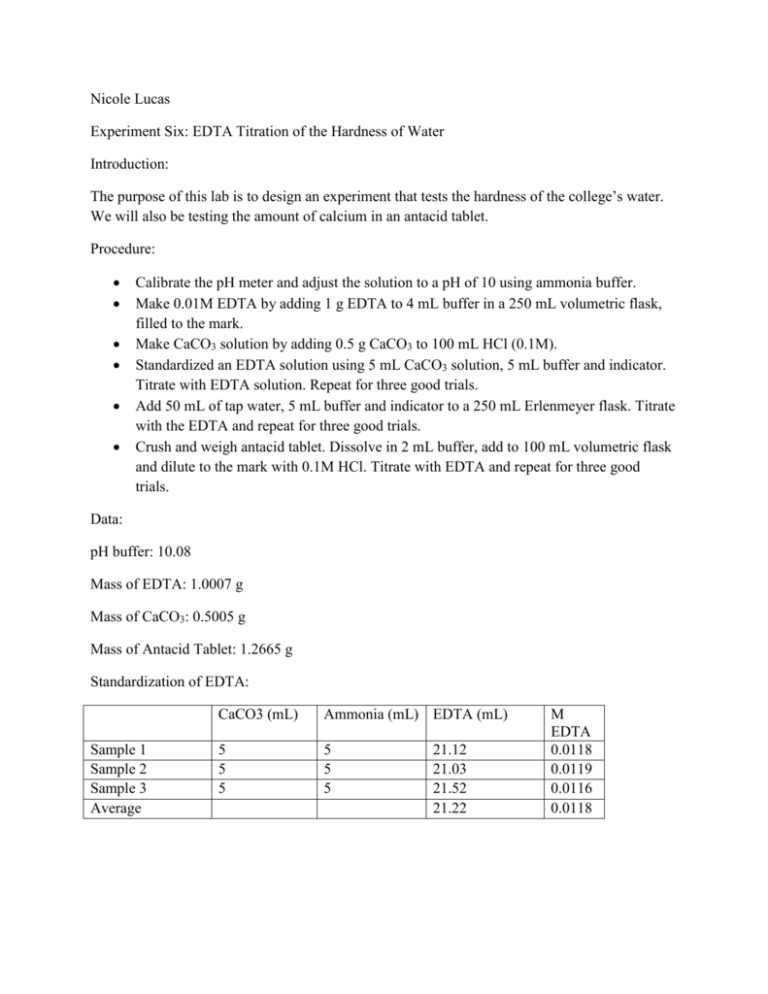
Nicole Lucas Experiment Six: EDTA Titration of the Hardness of Water Introduction: The purpose of this lab is to design an experiment that tests the hardness of the college’s water. We will also be testing the amount of calcium in an antacid tablet. Procedure: Calibrate the pH meter and adjust the solution to a pH of 10 using ammonia buffer. Make 0.01M EDTA by adding 1 g EDTA to 4 mL buffer in a 250 mL volumetric flask, filled to the mark. Make CaCO3 solution by adding 0.5 g CaCO3 to 100 mL HCl (0.1M). Standardized an EDTA solution using 5 mL CaCO3 solution, 5 mL buffer and indicator. Titrate with EDTA solution. Repeat for three good trials. Add 50 mL of tap water, 5 mL buffer and indicator to a 250 mL Erlenmeyer flask. Titrate with the EDTA and repeat for three good trials. Crush and weigh antacid tablet. Dissolve in 2 mL buffer, add to 100 mL volumetric flask and dilute to the mark with 0.1M HCl. Titrate with EDTA and repeat for three good trials. Data: pH buffer: 10.08 Mass of EDTA: 1.0007 g Mass of CaCO3: 0.5005 g Mass of Antacid Tablet: 1.2665 g Standardization of EDTA: Sample 1 Sample 2 Sample 3 Average CaCO3 (mL) Ammonia (mL) EDTA (mL) 5 5 5 5 5 5 21.12 21.03 21.52 21.22 M EDTA 0.0118 0.0119 0.0116 0.0118 Titration of Tap Water Sample 1 Sample 2 Sample 3 Average Tap Water (mL) 50 50 50 Ammonia (mL) 5 5 5 EDTA (mL) 4.28 4.01 3.98 4.09 [Ca 2+] 0.0118 0.0119 0.0116 0.0118 Hardness (ppm) 40.078 38.07 36.87 38.34 Titration of Antacid Sample 1 Sample 2 Sample 3 Average Antacid Solution (mL) 10 10 10 Calculations: Mass of EDTA needed: Molarity of EDTA: [Ca2+] in Tap Water: Ammonia (mL) 2 2 2 EDTA (mL) 16.13 16.61 16.26 16.33 Ca 2+ in tablet 0.076 0.079 0.076 0.077 % Ca 2+ in tablet 6.00 6.24 6.00 6.08 Hardness of Water: Grams of Calcium Ion in Tablet: Percent Calcium Ion in Sample: Percent Calcium Ion in Tablet Conclusion: The amount of calcium ion was determined to be on average 38.34 ppm, showing the college’s water is soft. The manufacturer’s antacid tablet contains 15.79% calcium ion. Our results showed an average percentage of 6.08%. This is a difference of almost 10%. The pH affects the form of EDTA in that as the pH gets lower, the percentage of EDTA formed gets lower. The purpose of the ammonia buffer is to maintain the pH of the solution. The reaction is pH dependent. Pyrocatecholphthalein is a common metallochromic indicator that could have been used in this experiment. Error in lab could have resulted from the antacid tablet not being completely transferred after crushing.

